Uninterruptible power supply unit: purpose and specifics of domestic UPS
To maintain the operability of devices in case of power outages, an uninterruptible power supply unit is used. Depending on the type of customers served and the parameters of electricity, you need to choose different models. These devices are in demand, therefore, it is not difficult to acquire the desired specimen according to its characteristics.
But before buying, you need to independently understand its features, and not trust this question to the managers interested in sales.
In this material we will consider the device and features of the UPS, and also talk about the rules for its use.
The content of the article:
AC UPS Circuits
For domestic use, devices for uninterrupted power are used, connected to a single-phase 220 V network, which can for some time in the absence of electricity supply consumers requiring the same voltage.
There are also UPSs that are connected to the input to a three-phase network, and the output is either 380 V or 220 V. However, they are expensive, they are used, if necessary, to obtain autonomous power from 10 kV · A, which is not required for domestic needs.
Household AC UPSs according to the operating scheme are divided into the following types:
- backup (offline);
- interactive (linearly interactive);
- double conversion (online).
They differ in the quality of the output voltage and price. The cheapest are backups, and the most expensive are double-conversion.
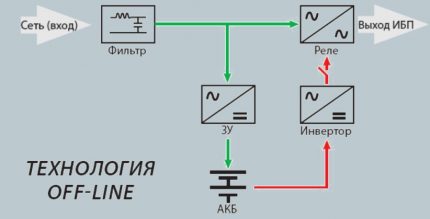
A rectifier is used in the charger to convert AC to DC. And the reverse transformation occurs using an inverter.
In uninterruptible power supplies, as a rule, ordinary electromechanical relays are installed to switch the circuit from the network to the battery. If this part is high-quality, then its resource is enough for the entire duration of the UPS operation. But most often, when a unit breaks down, the problem lies precisely in this structural element.
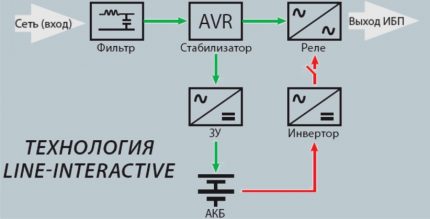
Voltage stabilization is also present in many household devices, so if the deviations are insignificant, then there is no point in acquiring a more expensive linear-interactive model.
The presence of a transformer often forces the manufacturer to use forced cooling, so such UPSs are equipped with coolers. They emit noise comparable in intensity to the operation of a computer system unit.
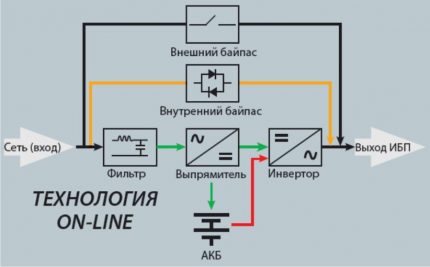
The most complex and expensive double conversion devices also have the lowest efficiency. Electricity goes into the heat that the device emits. Therefore, their use must be justified.
The most significant plus of this type of uninterruptible power supply is an instant reaction to a power outage. But for most household appliances, this is not so important. The same computers usually complete UPS backup or interactive type.
The most important parameters
There are many offers on the market for the sale of household uninterruptible power supplies. In order to correctly determine their purpose and not make a mistake with the choice, you need to understand what parameters you should pay attention to in the first place.
Key Specifications
The output power of the device determines the maximum permissible value that the unit can guaranteely give to the consumer. It is measured in volt-amperes (VA). For the convenience of users, this value is often quoted and in watts.
To measure the load of devices, you can either use an ammeter or calculate it using the readings of the meter installed in the apartment.
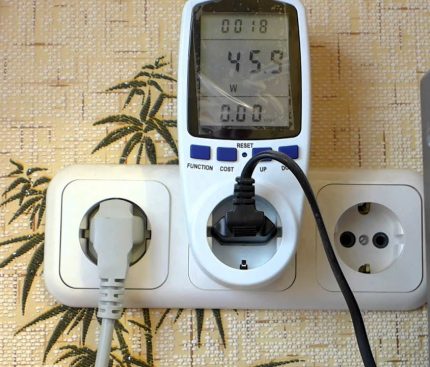
When determining the real power of a computer, one should not be guided by the rating of the power supply, since it is always bought with a margin.
If there is no ammeter, then you need to perform the following steps:
- Disconnect all circuits in the shield, except the one from which the computer is powered.
- Disconnect all appliances in this circuit.
- Turn on the computer and run a typical program on it (for example, a YouTube video).
- Wait until the tenth of a kilowatt changes on the counter.
- Take time before the next change.
Average power consumption (P, watt) for this period (t, minutes) can be calculated by the formula:
P = 100 * (60 / t)
The next important characteristic is the battery life. This indicator depends on the load that the UPS is currently experiencing. At the maximum allowable power, the batteries of the household device last 1-3 minutes. And in the half - much longer (up to 10 minutes).
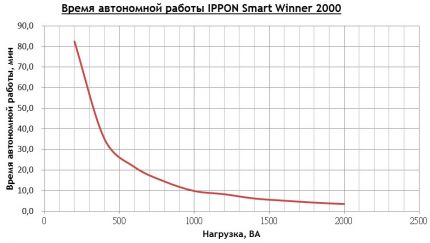
Two conclusions follow from this:
- during a power outage, it is necessary to minimize the load consumed by the devices;
- It is advisable to purchase a UPS with a capacity that exceeds the calculated by at least 30%.
The input voltage range shows the minimum and maximum allowable voltage of the network, at which there will be no switching of power to the batteries. As a rule, all UPSs withstand an interval of 180-260 V.
Some manufacturers can meet very good (advertising) indicators, for example, the lower value is 110 V. Here you need to make sure that these numbers are taken just for the maximum load, and not for half.
Another important technical indicator is the noise level. Line-interactive or online UPSs generate a lot of heat, so manufacturers install fans on them. If coolers are cheap, then over time they will make a buzz, which is undesirable for a living room.
Interface and setup
The appearance of the blocks can be very diverse. Usually they have a classic rectangular shape, where on the front side there are indicators or a display, and on the back there are power connectors. Their number is not so important, since at the output you can connect an extension cord with a tee. This will not contradict the concept of UPS.
The model may have a lcd display, on which the situation with the supply of connected devices will be displayed: availability of power, number of consumers, battery charge, etc.
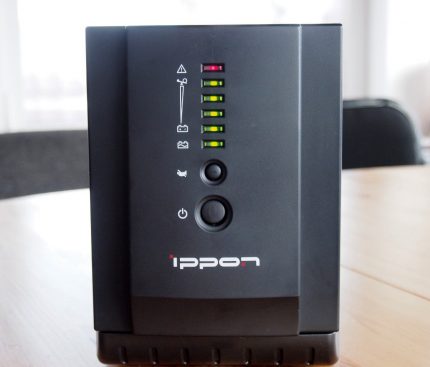
To find out the parameters of power supply, the condition of the UPS batteries and how it works, you can connect it to a computer. For many models, this function is implemented and software is developed.
There are three main types of interface:
- USB The most common connection between a computer and a UPS.
- RS-232 (COM port). Rarely present in household models.
- Ethernet 10/100. It is used for remote control of an uninterruptible power supply.
The software for obtaining characteristics with the UPS and its management is developed not only for various versions of Windows. So, for example, the well-known manufacturer Powercom has an Android version of the software that allows you to remotely monitor the power status and, if necessary, adjust the operation of the uninterruptible power supply.
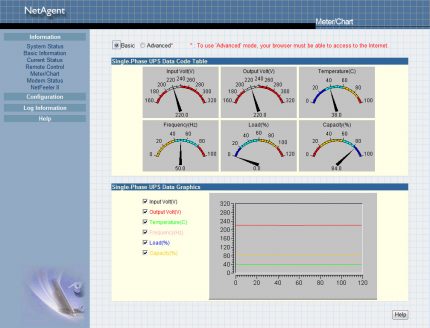
Uninterruptible power units are placed in the immediate vicinity of the protected consumers of electricity. They are usually placed on the floor or on shelves. Some models are equipped with fasteners that allow you to mount them on the walls.
Output Current Quality
Uninterruptible power supplies must produce current of proper quality. When operating from batteries, the inverter is responsible for this, and in the case of power from the network, problematic moments should smooth the filters and the stabilizer. Interferences arising in an electric circuit have different genesis and consequences for electronics. Therefore, this issue also needs to be carefully understood.
Network Interference and Protection
All modern UPSs are equipped with protection against problems associated with serviced devices. If the total load exceeds the maximum permissible or a short circuit occurs, the uninterruptible power supply will immediately turn off the power.
Network interference can be divided into frequency and pulse. The former are not so dangerous, especially for power supplies for computers or televisions, which convert alternating current into direct current. The latter can cause a problem in any electronics.
Therefore, most UPSs are equipped with surge and harmonic protection with varistors and high-pass filters.
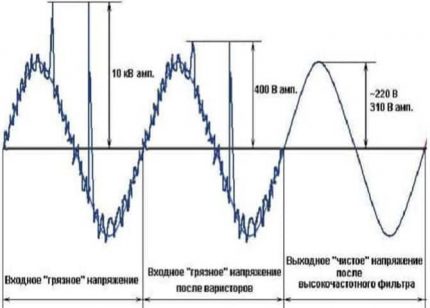
The problem of the appearance of high-voltage pulses is characteristic not only for power cables, but also for data transmission networks - computer or telephone.They can occur due to exposure to atmospheric electricity, breakdowns of nearby wiring, electrical interference and other causes.
Many manufacturers produce models with the ability to protect the local network. For this, the UPS has two RJ-45 Connector - one at the entrance and one at the exit. The signal passes through a filter that suppresses surges. The system is the same for telephone lines, only the connectors are in RJ-11 format.
Low and high voltage
The voltage adjustment is carried out using an automatic voltage regulator (AVR), the main element of which is an autotransformer. The principle of its operation is based on a change in the number of turns of one of the windings, resulting in a change in voltage in the direction of increasing or decreasing its value.
The presence of AVR in the UPS allows you to not turn on the autonomous mode every time with a slight deviation of voltage from the standard indicators. This significantly increases battery life.
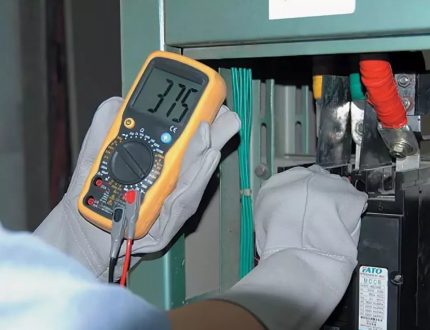
According to GOST 29322-2014, a 10% deviation of the voltage from the reference value for a period of not more than 1 hour is permissible. All modern UPSs with regulators cope with such fluctuations.
Output Clarity
The type of output signal depends on the model of the inverter that is installed in the UPS. Ideally, the AC voltage curve should be a sine wave. But after conversion through the inverter, it takes a stepwise form.
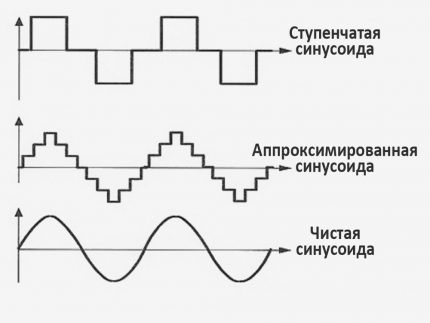
Equipment that contains asynchronous motors (refrigerator, air conditioning), transformer power supplies (high-quality audio equipment), APFC power supplies (servers and powerful computing computers) need a clean or well-approximated sine wave.
Not a single inverter, and therefore, the UPS does not give a pure sine wave, so that equipment manufacturers do not write in advertising brochures. The approximation of the output signal to the sine wave is evaluated through the coefficient of non-linear distortion (THD).
The signal coming from the block can be considered sinusoidal at THD <5%. For some models, such as IMV NetPro 2000, this figure is only 2%.
UPS Usage Rules
When purchasing an uninterruptible power supply for organizing backup power, you need to understand in conjunction with which devices it can be used. Sometimes it is impossible to manage only a UPS, and then additional measures need to be taken to provide electricity to the house.
Connection of household appliances
Computers, modems, routers, video and audio equipment are typical home or office devices to which uninterruptible power supplies are connected. If this technique contains ordinary switching power supplies, then it will be enough to purchase relatively cheap models that do not produce a pure sine wave.
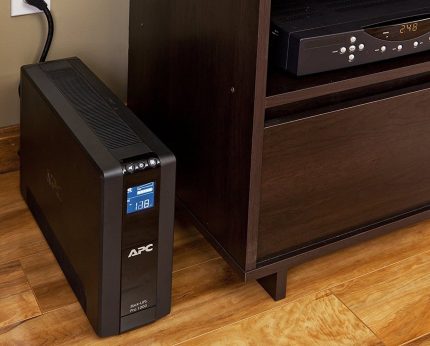
For lighting, you also do not need to purchase expensive products. The main thing here is to correctly calculate the maximum power and battery life.
With frequent blackouts, the problem of unplanned defrosting of refrigerators and food spoilage is relevant. To protect such equipment with induction motors, UPS of a more complex device will be needed, since a “pure” sinusoidal signal is required.
In addition, it is necessary to take into account the presence of starting currents that occur when the engine is started. Simplified for refrigeration equipment, their value can be determined by multiplying the power value by 5.
If, for example, the kitchen has a refrigerator with a total power of 300 watts (at start-up - 1,500 watts) and a freezer for 200 watts (at start-up - 1,000 watts), then you need a power supply with a pure sine wave and a maximum power of at least 1,700 watts. This value is obtained in the case when the freezer will work, and at this time the refrigerator will turn on. The simultaneous start of both motors is unlikely, and even such a UPS can withstand a one-second surge of 2.7 kW.
An online type block with a maximum power of 2000 watts can work for about half an hour with a total consumption of 500 watts. Since the cooling mode takes about 5 minutes, the uninterruptible power supply is guaranteed to last for 6 starts of both devices.
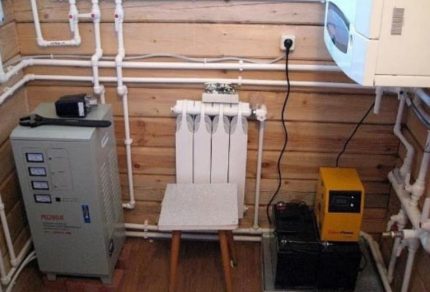
Uninterruptible power supplies are also actively used for the operation of gas heating boilers. Given the cost of the connected equipment, you should not save on the quality of the UPS in this case.
Reserve and additional power supply
For many household appliances, it is impossible to choose an inexpensive UPS, since significant maximum power will be needed for a long period of battery life. Washing machines, electric ovens, distributed air conditioning systems consume a lot of electricity.
You can, of course, do without these devices during a power outage. This is advisable if such interruptions occur rarely and for a short time. But if, nevertheless, a decision is made to provide powerful consumers with autonomous power, it is better to use a gasoline or diesel generator. For their quick start in the absence of voltage, an automatic reserve input system (ATS) is used.
If you have an additional power source, the UPS should still be used, at least for computers. It is impossible to start the generator immediately and restore power supply.
Undervoltage stabilization
The problem of undervoltage is relevant for objects connected to old or low-power networks. If this situation arises constantly, it is better to use the input stabilizer.
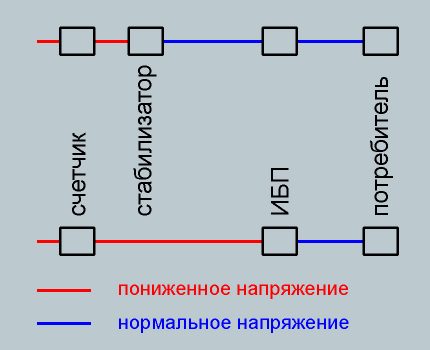
With a reduced voltage, the strength of the current passing through the house network increases. For example, let the total power of the consumers connected to the UPS be 1.5 kW and the supply voltage equal to 190 V.
Then by Ohm's law:
- I1 = 1500/190 = 7.9 A - current in the circuit to the UPS without a stabilizer;
- I2 = 1500/220 = 6.8 A - current in the circuit to the UPS with a stabilizer.
Thus, an intra-house network without a stabilizer will experience an increased load, which could not be taken into account when choosing the wiring section.
Therefore, with a constant low voltage, it is better to install a stabilizer. In this case, the load on the autotransformer of the UPS will be less, which will extend its service life. In addition, taking into account the alignment of the voltage, you can purchase cheaper uninterruptible power supplies.
Uninterruptible power supply of direct current consumers
For some devices, you need to provide uninterrupted DC power 12, 24 or 48 V. UPS of this kind is also on sale. In their marking there is an abbreviation “DC”. Blocks with a voltage supply of 60, 110 or 220 V also exist, but they are used in industry or energy.
The difference between uninterruptible DC power in the internal device from the classic models is the lack of an inverter. Batteries are connected directly to the output through a contactor with a current-limiting measuring shunt to prevent an unacceptably deep discharge of the batteries.
Sometimes a stabilizing converter may be installed at the output if the devices powered by the UPS are sensitive to small voltage fluctuations.
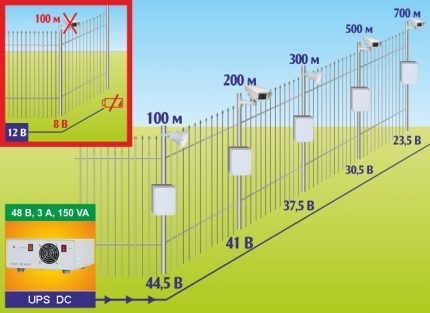
Such redundant power supplies are used to protect the following household equipment operating from direct current:
- video surveillance systems and security;
- all kinds of sensors (leaks, smoke, fire, movement, etc.);
- lighting systems;
- telecommunication devices;
- communication systems;
- control system components "smart House".
Many DC UPSs have the option of connecting external batteries. In this case, the autonomous functioning of the devices they serve can be very long.
Conclusions and useful video on the topic
Briefly about the main characteristics of household UPS:
The variety of UPS types and their characteristics is a consequence of different conditions for their use: power and type of connected devices, parameters and typical problems of a particular power supply. An uninterrupted power supply is usually not the most expensive element in a system, but the stability of its operation depends on it. Therefore, it is necessary to determine the operating conditions and carefully approach the choice of model.
Still have questions about the topic of the article? Or can you supplement this material with interesting UPS information? Please write your comments, ask questions, share experiences in the block below.

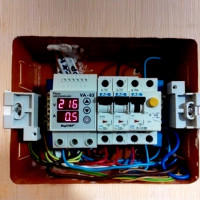 Voltage control relays: operating principle, circuit, connection nuances
Voltage control relays: operating principle, circuit, connection nuances 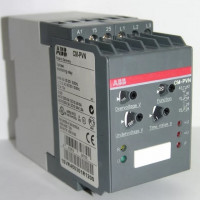 Phase control relays: operating principle, types, marking + how to adjust and connect
Phase control relays: operating principle, types, marking + how to adjust and connect 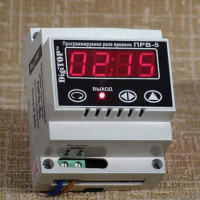 Time relay: operating principle, wiring diagram and tuning recommendations
Time relay: operating principle, wiring diagram and tuning recommendations 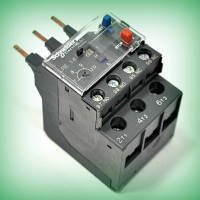 Thermal relay for an electric motor: operating principle, device, how to choose
Thermal relay for an electric motor: operating principle, device, how to choose  Thermal relay: operating principle, types, connection diagram + adjustment and marking
Thermal relay: operating principle, types, connection diagram + adjustment and marking 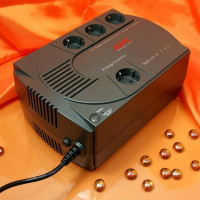 Uninterruptible for TV: 12 best UPS models + valuable tips before buying
Uninterruptible for TV: 12 best UPS models + valuable tips before buying  How much does it cost to connect gas to a private house: the price of organizing gas supply
How much does it cost to connect gas to a private house: the price of organizing gas supply  The best washing machines with dryer: model rating and customer tips
The best washing machines with dryer: model rating and customer tips  What is the color temperature of light and the nuances of choosing the temperature of the lamps to suit your needs
What is the color temperature of light and the nuances of choosing the temperature of the lamps to suit your needs  Replacement of a geyser in an apartment: replacement paperwork + basic norms and requirements
Replacement of a geyser in an apartment: replacement paperwork + basic norms and requirements